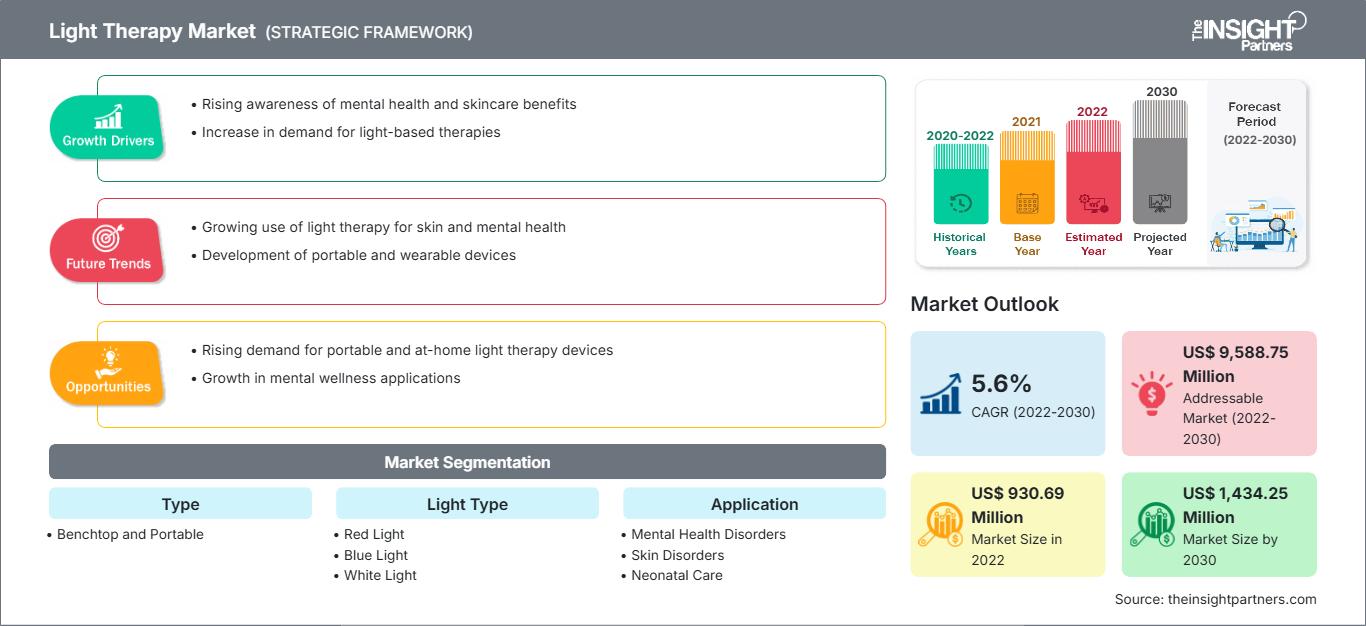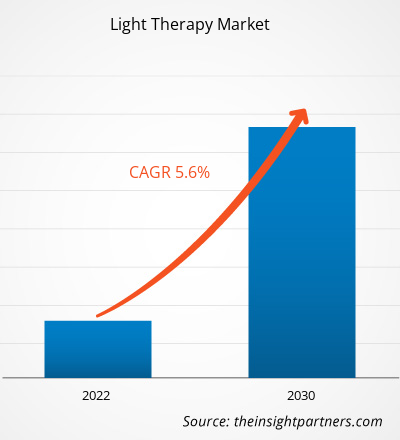[調査レポート] 光線療法市場規模は、2022年の9億3,069万米ドルから2030年には14億3,425万米ドルに拡大すると予測されており、2022年から2030年にかけて5.6%の年平均成長率(CAGR)を記録すると見込まれています。
市場分析とアナリストの見解:
光線療法は、特定の波長の光を用いた治療で、皮膚疾患、気分障害、睡眠障害などのさまざまな症状に対処します。この非侵襲性治療法は、光の独自の特性を利用して体内の生物学的反応を引き起こし、多くの場合、皮膚や網膜を標的とし、概日リズムや気分調節経路に影響を与えます。光療法には、ニキビに対する青色光療法、肌の若返りのための赤色光療法、季節性情動障害に対する高輝度光療法など、さまざまな形態があります。
成長要因と課題:
皮膚疾患に対する青色光療法の導入増加は、光療法市場の成長と多様化を推進する重要な要因となっています。非侵襲性の光線療法である青色光療法は、ニキビ、乾癬、湿疹、日光角化症など、さまざまな皮膚疾患の治療に利用が拡大しています。尋常性ざ瘡などの特定の皮膚疾患に対する青色光療法の有効性は、医療従事者や非薬物療法を求める人々の間で広く注目され、受け入れられています。技術革新により青色光療法の応用はさらに拡大し、皮膚疾患の根本原因を選択的に標的とし、緩和する最適化された青色光波長を備えた特殊な光送達システムが開発されました。家庭用ブルーライトセラピー機器の入手しやすさも市場の拡大に貢献しており、個人が便利で使いやすいソリューションで肌の悩みに対処できるようになりました。
一方、光線療法はさまざまな治療効果をもたらしますが、特定の治療法に伴う副作用のリスクが、光線療法市場全体の成長を制限する要因として浮上しています。皮膚の炎症、眼精疲労、概日リズムの乱れなど、潜在的な副作用に対する懸念から、医療従事者と潜在的なユーザーの両方が注意を促しています。これらの懸念は、特に安全で適切な使用に関する情報やガイダンスが不十分な場合、個人が光線療法の選択肢を検討することを思いとどまらせる可能性があります。さらに、綿密な線量測定と治療プロトコルの遵守の必要性、そして敏感な個人における副作用の可能性が相まって、広範な導入の障壁となっています。継続的な研究、教育、強化された安全対策の開発を通じてこれらのリスクを軽減することは、これらの制限に対処し、光線療法の安全性と有効性に対する信頼を高め、それによって光線療法のより広範な利用を促進し、市場の成長に貢献するために不可欠です。
要件に合わせてレポートをカスタマイズ
レポートの一部、国レベルの分析、Excelデータパックなどを含め、スタートアップ&大学向けに特別オファーや割引もご利用いただけます(無償)
光療法市場: 戦略的洞察

- このレポートの主要な市場動向を入手してください。この無料サンプルには、市場動向から見積もりや予測に至るまでのデータ分析が含まれます。
レポートの一部、国レベルの分析、Excelデータパックなどを含め、スタートアップ&大学向けに特別オファーや割引もご利用いただけます(無償)
光療法市場: 戦略的洞察

- このレポートの主要な市場動向を入手してください。この無料サンプルには、市場動向から見積もりや予測に至るまでのデータ分析が含まれます。
レポートのセグメンテーションと範囲:
光線療法市場は、タイプ、光の種類、用途、およびエンドユーザーに基づいて分割されています。 タイプに基づいて、市場はベンチトップとポータブルに分かれています。 光線療法市場は、光の種類によって赤色光、青色光、白色光に分割されています。 用途別に、市場は精神疾患、皮膚疾患、新生児黄疸、その他に分類されています。 エンドユーザーの観点から、市場は病院と専門クリニック、在宅ケア、その他に分類されています。 地理的には、光線療法市場は北米 (米国、カナダ、メキシコ)、ヨーロッパ (イギリス、ドイツ、フランス、イタリア、スペイン、その他のヨーロッパ)、アジア太平洋 (中国、日本、インド、オーストラリア、韓国、その他のアジア太平洋)、中東およびアフリカ (UAE、サウジアラビア、南アフリカ、その他の中東およびアフリカ)、南アフリカ中央アメリカ(ブラジル、アルゼンチン、その他の中南米)。
セグメント分析:
タイプ別に見ると、光線療法市場におけるポータブルセグメントは、2022年から2030年にかけて最も高いCAGRを記録すると予想されています。ポータブル光療法デバイスは、光療法のアクセス性と利便性に革命をもたらし、外出先でも治療効果を得られるようになりました。これらのポータブルソリューションには、コンパクトなライトボックス、ウェアラブルライトバイザー、ハンドヘルドライトワンドなど、様々な環境でターゲットを絞った光線療法を提供できるように設計された幅広いデバイスが含まれます。これらのデバイスの携帯性により、ユーザーは自宅、職場、旅行中など、日常生活に光療法をシームレスに統合できます。その結果、ポータブル光療法は光療法の範囲を拡大し、個人が健康管理をより細かく管理できるようになり、処方された光線療法プロトコルの遵守を強化しています。
光療法市場は、光の種類別に、赤色光、青色光、白色光に分類されます。赤色光療法は、細胞内で生化学反応を起こすことでミトコンドリアを強化する能力があるため、今後数年間で大きな注目を集めると予想されています。赤色光療法はアデノシン三リン酸(ATP)の産生を増加させ、発毛、傷の治癒、組織の修復、日焼けによるダメージの回復を促すと言われています。
用途別に見ると、光線療法市場は精神疾患、皮膚疾患、新生児ケアなどに分類されます。2022年には病院の皮膚疾患セグメントが市場を席巻し、予測期間中に大幅なCAGRを記録すると予想されています。ニキビ、乾癬、湿疹、皮膚炎などの皮膚疾患の治療における光線療法の有効性は、医療従事者や非薬理学的介入を求める人々の間で広く採用されるきっかけとなっています。このセグメントは、特定の波長の光が皮膚細胞と関連する生物学的プロセスに及ぼす光生物学的調節効果を解明する研究の進歩により、著しい成長を遂げています。
地域分析:
地理に基づいて、光線療法市場は、北米、ヨーロッパ、アジア太平洋、中東およびアフリカ、南米および中米に分類されます。
北米は、乾癬やSAD/冬季うつ病の症状を持つ人の数が増加しているため、この市場の成長に最も大きく貢献しており、2022年には北米が光線療法の世界市場をリードしました。医師の管理下で、光線療法では人工光源からの紫外線に皮膚をさらします。UVB光とUVA光、またはその2つを組み合わせて、症状を緩和し、炎症を抑え、皮膚細胞の増殖を抑えます。カナダ皮膚科学会は、カナダで100万人が乾癬を患っていると推定しており、これが光線療法機器の需要を牽引する重要な要因となっています。アジア太平洋地域の光線療法市場は、遠隔医療への巨額の投資と光線療法の利点に関する知識の高まりにより、2022年から2030年にかけて最も高いCAGRを記録すると予想されています。
光線療法光線療法市場の地域別分析
The Insight Partnersのアナリストは、予測期間を通じて光療法市場に影響を与える地域的な傾向と要因を詳細に解説しています。このセクションでは、北米、ヨーロッパ、アジア太平洋、中東・アフリカ、中南米における光療法市場のセグメントと地域についても解説しています。
光線療法市場レポートの範囲
| レポート属性 | 詳細 |
|---|---|
| の市場規模 2022 | US$ 930.69 Million |
| 市場規模別 2030 | US$ 1,434.25 Million |
| 世界的なCAGR (2022 - 2030) | 5.6% |
| 過去データ | 2020-2022 |
| 予測期間 | 2022-2030 |
| 対象セグメント |
By タイプ
|
| 対象地域と国 | 北米
|
| 市場リーダーと主要企業の概要 |
|
光線療法市場のプレーヤー密度:ビジネスダイナミクスへの影響を理解する
光療法市場は、消費者の嗜好の変化、技術の進歩、製品効果への認知度の高まりといった要因によるエンドユーザーの需要増加に牽引され、急速に成長しています。需要の増加に伴い、企業は製品ラインナップの拡充、消費者ニーズへの対応のための革新、そして新たなトレンドの活用を進めており、これが市場の成長をさらに加速させています。

- 入手 光療法市場 主要プレーヤーの概要
業界の発展と将来の機会:
世界の光療法市場で事業を展開している主要企業による取り組みをいくつかご紹介します。
- 2023年9月、スキンケアおよび美容技術ソリューションの大手サプライヤーであるAMIROは、今年最も最先端な2つの製品、AMIRO S2 SEALスキンタイトニングガジェットとAMIRO LumoMax LEDライトフェイシャルビューティーデバイスを発表しました。
- 2022年6月、BioPhotas, Inc.はUlta Beautyと提携しました。Celluma PROおよびCelluma ELITEモデルの支援により、この協力関係は米国全土の55の異なる地域で顧客のスキンケアニーズを満たすことが期待されています。 FDAは、しわ、関節の不快感、ニキビなど、様々な疾患の治療にこれらのモデルを承認しています。
競合状況と主要企業:
Koninklijke Philips NV、Beurer GmbH、BioPhotas、Northern Light Technologies、Lumie、Verilux, Inc、Zepter International、The Daylight Company、Zerigo Health、Naturebrightは、光線療法市場の主要企業です。これらの企業は、世界中で高まる消費者需要に対応するため、製品の拡充に注力しています。グローバル展開により、多くの顧客にサービスを提供し、市場シェアを拡大しています。
- 過去2年間の分析、基準年、CAGRによる予測(7年間)
- PEST分析とSWOT分析
- 市場規模価値/数量 - 世界、地域、国
- 業界と競争環境
- Excel データセット
最新レポート
お客様の声
購入理由
- 情報に基づいた意思決定
- 市場動向の理解
- 競合分析
- 顧客インサイト
- 市場予測
- リスク軽減
- 戦略計画
- 投資の正当性
- 新興市場の特定
- マーケティング戦略の強化
- 業務効率の向上
- 規制動向への対応




















 無料サンプルを入手 - 光療法市場
無料サンプルを入手 - 光療法市場